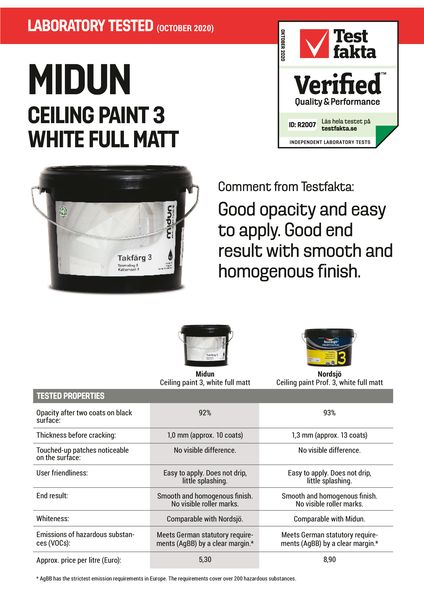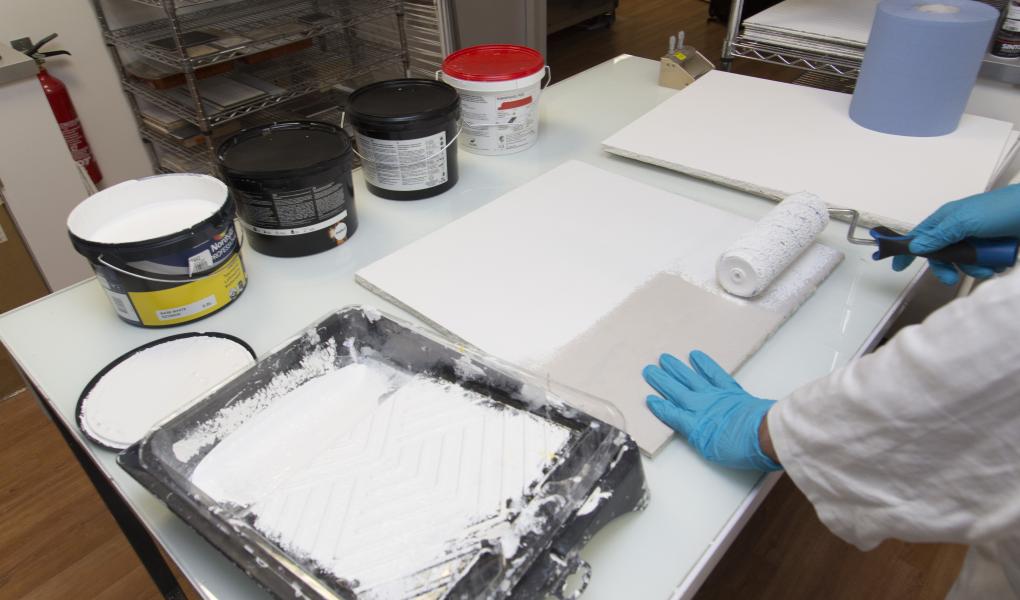Testfakta’s quality standard has tough criteria. The ceiling paint undergoes a standardised testing regime that covers opacity, ease of use, finish and emissions of volatile organic compounds. To meet the criteria for Testfakta’s quality standard, the ceiling paint must perform consistently well in every part of the test, match the information stated on the product and meet the threshold value for emissions of volatile organic compounds. Carrying the Verified Quality & Performance mark guarantees that the product offers thoroughly good quality.´
To obtain an idea about Midun’s relative quality and performance, the product has been tested against and compared with Nordsjö Professional ceiling paint. The results of the laboratory test show that the products are equivalent.
The laboratory test was conducted by Eurofins ATS in France and Eurofins Product Testing in Denmark, with the Danish lab carrying out the emissions testing and the French lab focusing on quality and performance.
 The test involved the following elements:
The test involved the following elements:
Opacity
Two wide, black stripes are painted on a plasterboard panel and left to fully dry. The black stripes are then painted over with two coats of the ceiling paint, with a drying time of 4 hours between the coats. The painted surface is left to dry for a further 7 hours, before the opacity of the ceiling paint is measured and assessed. The opacity is stated as a percentage.
Cracking
The paint is applied in varying numbers of layers up to a thickness of max 2 mm (20 layers). After 2 weeks, the differently layered surfaces are checked for the formation of cracks. A note is made of the lowest number of layers at which cracks form. The more layers until cracking, the better.
Touch-up painting
To simulate touch-up painting of an already painted surface, a plasterboard panel is painted with three coats of paint. After 30 minutes and after 7 days, a small section of the panel’s already painted surface is painted over again. Differences between the touched-up area and the surrounding areas are assessed.
End result
Two coats of paint are applied to a plasterboard panel, with a drying time of 4 hours between the coats. The painted surface is then left to dry for a further 7 hours, before the end result is assessed. The assessment includes the finish, roller marks and any unevenness on the painted surface.
Application
Ease of use when applying with a roller is assessed. How easy is it to work with – does it run, drip and splash/spray a lot during painting? Any and all problems during application are reported.
Emissions analysis
The laboratory has analysed the amount of volatile organic compounds (VOCs) that the ceiling paint releases into the indoor air. Volatile organic compounds are chemicals that may cause allergic reactions, headaches and sickness.The measurement is taken after 3 days and 28 days. The results of the analysis are compared with Germany’s statutory requirements concerning emissions from building products (AgBB). The Swedish regulations do not govern the amount of VOCs building products are permitted to emit.

